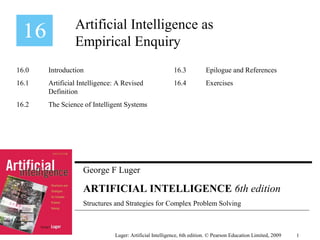Artificial Intelligence
•Download as PPT, PDF•
1 like•211 views
George F Luger Sixth ed chap 16
Report
Share
Report
Share

Recommended
Recommended
More Related Content
Viewers also liked
Viewers also liked (20)
Similar to Artificial Intelligence
Similar to Artificial Intelligence (20)
Opening the door to the Chinese Room: Intersubjectivity and the Phenomenology...

Opening the door to the Chinese Room: Intersubjectivity and the Phenomenology...
Artificial intelligence uses in productive systems and impacts on the world...

Artificial intelligence uses in productive systems and impacts on the world...
More from Muhammad Ahad
More from Muhammad Ahad (11)
03. non-functional-attributes-introduction-4-slides

03. non-functional-attributes-introduction-4-slides
Recently uploaded
Enterprise Knowledge’s Urmi Majumder, Principal Data Architecture Consultant, and Fernando Aguilar Islas, Senior Data Science Consultant, presented "Driving Behavioral Change for Information Management through Data-Driven Green Strategy" on March 27, 2024 at Enterprise Data World (EDW) in Orlando, Florida.
In this presentation, Urmi and Fernando discussed a case study describing how the information management division in a large supply chain organization drove user behavior change through awareness of the carbon footprint of their duplicated and near-duplicated content, identified via advanced data analytics. Check out their presentation to gain valuable perspectives on utilizing data-driven strategies to influence positive behavioral shifts and support sustainability initiatives within your organization.
In this session, participants gained answers to the following questions:
- What is a Green Information Management (IM) Strategy, and why should you have one?
- How can Artificial Intelligence (AI) and Machine Learning (ML) support your Green IM Strategy through content deduplication?
- How can an organization use insights into their data to influence employee behavior for IM?
- How can you reap additional benefits from content reduction that go beyond Green IM?
Driving Behavioral Change for Information Management through Data-Driven Gree...

Driving Behavioral Change for Information Management through Data-Driven Gree...Enterprise Knowledge
Recently uploaded (20)
Raspberry Pi 5: Challenges and Solutions in Bringing up an OpenGL/Vulkan Driv...

Raspberry Pi 5: Challenges and Solutions in Bringing up an OpenGL/Vulkan Driv...
ProductAnonymous-April2024-WinProductDiscovery-MelissaKlemke

ProductAnonymous-April2024-WinProductDiscovery-MelissaKlemke
Exploring the Future Potential of AI-Enabled Smartphone Processors

Exploring the Future Potential of AI-Enabled Smartphone Processors
Boost Fertility New Invention Ups Success Rates.pdf

Boost Fertility New Invention Ups Success Rates.pdf
What Are The Drone Anti-jamming Systems Technology?

What Are The Drone Anti-jamming Systems Technology?
08448380779 Call Girls In Friends Colony Women Seeking Men

08448380779 Call Girls In Friends Colony Women Seeking Men
Driving Behavioral Change for Information Management through Data-Driven Gree...

Driving Behavioral Change for Information Management through Data-Driven Gree...
The Role of Taxonomy and Ontology in Semantic Layers - Heather Hedden.pdf

The Role of Taxonomy and Ontology in Semantic Layers - Heather Hedden.pdf
From Event to Action: Accelerate Your Decision Making with Real-Time Automation

From Event to Action: Accelerate Your Decision Making with Real-Time Automation
Strategies for Landing an Oracle DBA Job as a Fresher

Strategies for Landing an Oracle DBA Job as a Fresher
08448380779 Call Girls In Greater Kailash - I Women Seeking Men

08448380779 Call Girls In Greater Kailash - I Women Seeking Men
Boost PC performance: How more available memory can improve productivity

Boost PC performance: How more available memory can improve productivity
Scaling API-first – The story of a global engineering organization

Scaling API-first – The story of a global engineering organization
How to Troubleshoot Apps for the Modern Connected Worker

How to Troubleshoot Apps for the Modern Connected Worker
Strategies for Unlocking Knowledge Management in Microsoft 365 in the Copilot...

Strategies for Unlocking Knowledge Management in Microsoft 365 in the Copilot...
Artificial Intelligence
- 1. George F Luger ARTIFICIAL INTELLIGENCE 6th edition Structures and Strategies for Complex Problem Solving Artificial Intelligence as Empirical Enquiry Luger: Artificial Intelligence, 6th edition. © Pearson Education Limited, 2009 16.0 Introduction 16.1 Artificial Intelligence: A Revised Definition 16.2 The Science of Intelligent Systems 16.3 Epilogue and References 16.4 Exercises 1
- 2. Based on our experience of the last 16 chapters, we offer a revised definition of Artificial Intelligence: AI is the study of mechanisms underlying behaviour through the construction and evaluation of artefacts that attempt to enact those mechanisms Luger: Artificial Intelligence, 6th edition. © Pearson Education Limited, 2009 2
- 3. The necessary and sufficient condition for a physical system to exhibit general intelligent action is that it be a physical symbol system. Sufficient means that intelligence can be achieved by any appropriately organized physical symbol system. Necessary means that any agent that exhibits general intelligence must be an instance of a physical symbol system. The necessity of the physical symbol system hypothesis requires that any intelligent agent, whether human, space alien, or computer, achieve intelligence through the physical implementation of operations on symbol structures. General intelligent action means the same scope of action seen in human action. Within physical limits, the system exhibits behavior appropriate to its ends and adaptive to the demands of its environment. Luger: Artificial Intelligence, 6th edition. © Pearson Education Limited, 2009 3
- 4. Fig 16.1 Truncated chessboard with two squares covered by a domino. Luger: Artificial Intelligence, 6th edition. © Pearson Education Limited, 2009 4
- 5. Fig 16.2 A set of data points and three function approximations. Luger: Artificial Intelligence, 6th edition. © Pearson Education Limited, 2009 5
- 6. Critical questions that remain for creating artificial intelligence: 1. The representation problem. 2. The role of embodiment in cognition. 3. Culture and intelligence. 4. Characterizing the nature of interpretation. 5. Representational indeterminacy. 6. The necessity of designing computational models that are falsifiable. 7. The limitations of the scientific method. Luger: Artificial Intelligence, 6th edition. © Pearson Education Limited, 2009 6
- 7. Critical questions that remain for creating artificial intelligence: 1. The representation problem. 2. The role of embodiment in cognition. 3. Culture and intelligence. 4. Characterizing the nature of interpretation. 5. Representational indeterminacy. 6. The necessity of designing computational models that are falsifiable. 7. The limitations of the scientific method. Luger: Artificial Intelligence, 6th edition. © Pearson Education Limited, 2009 6
